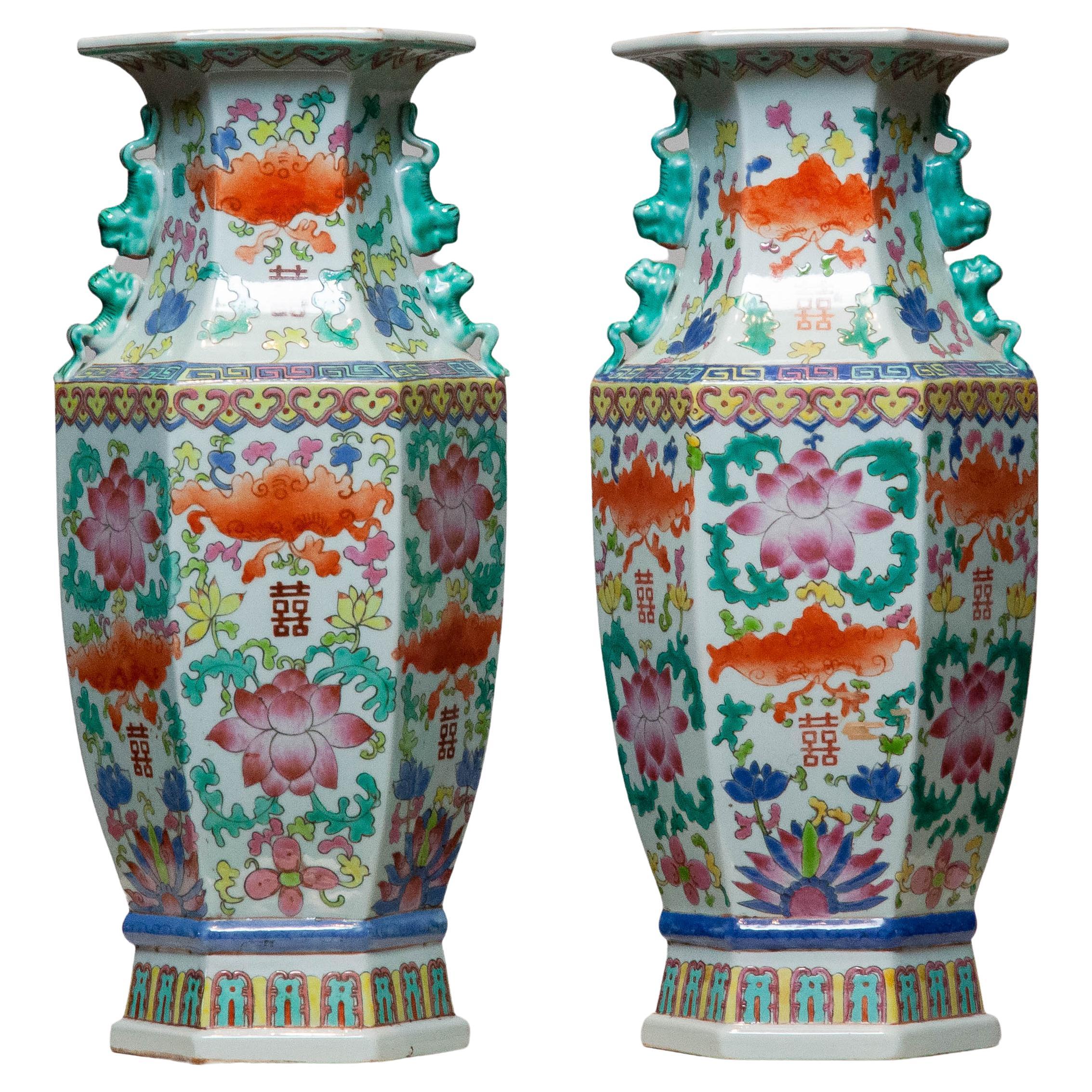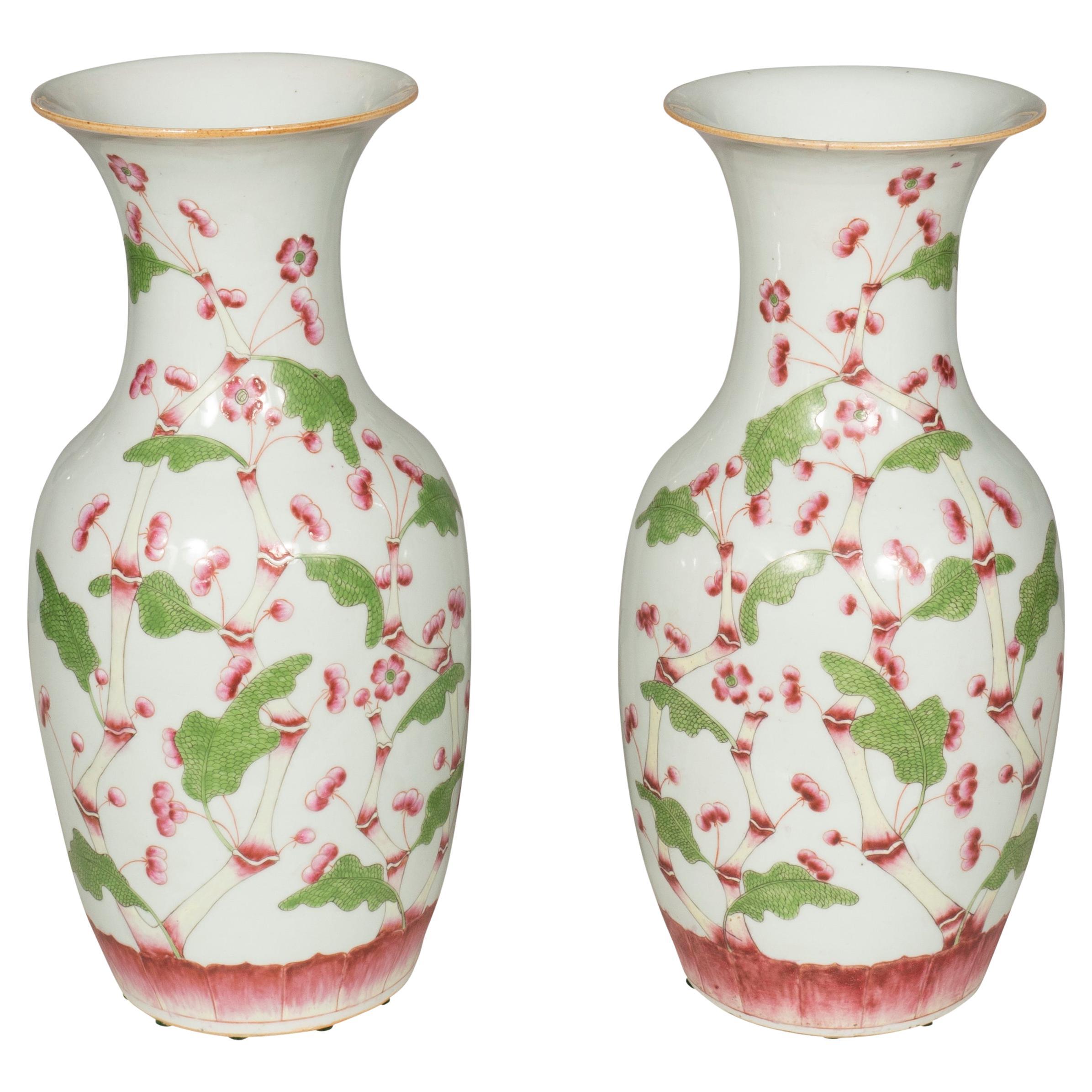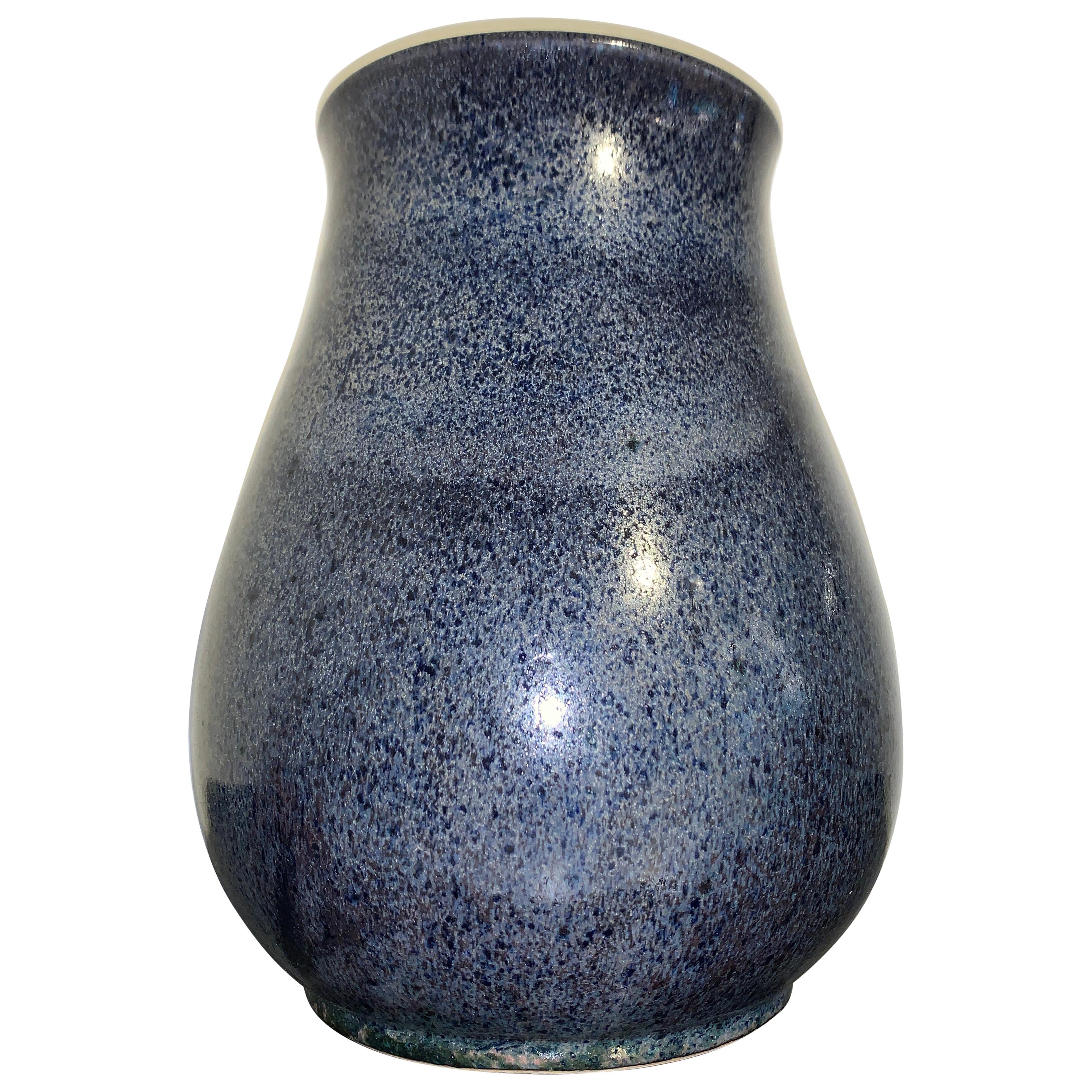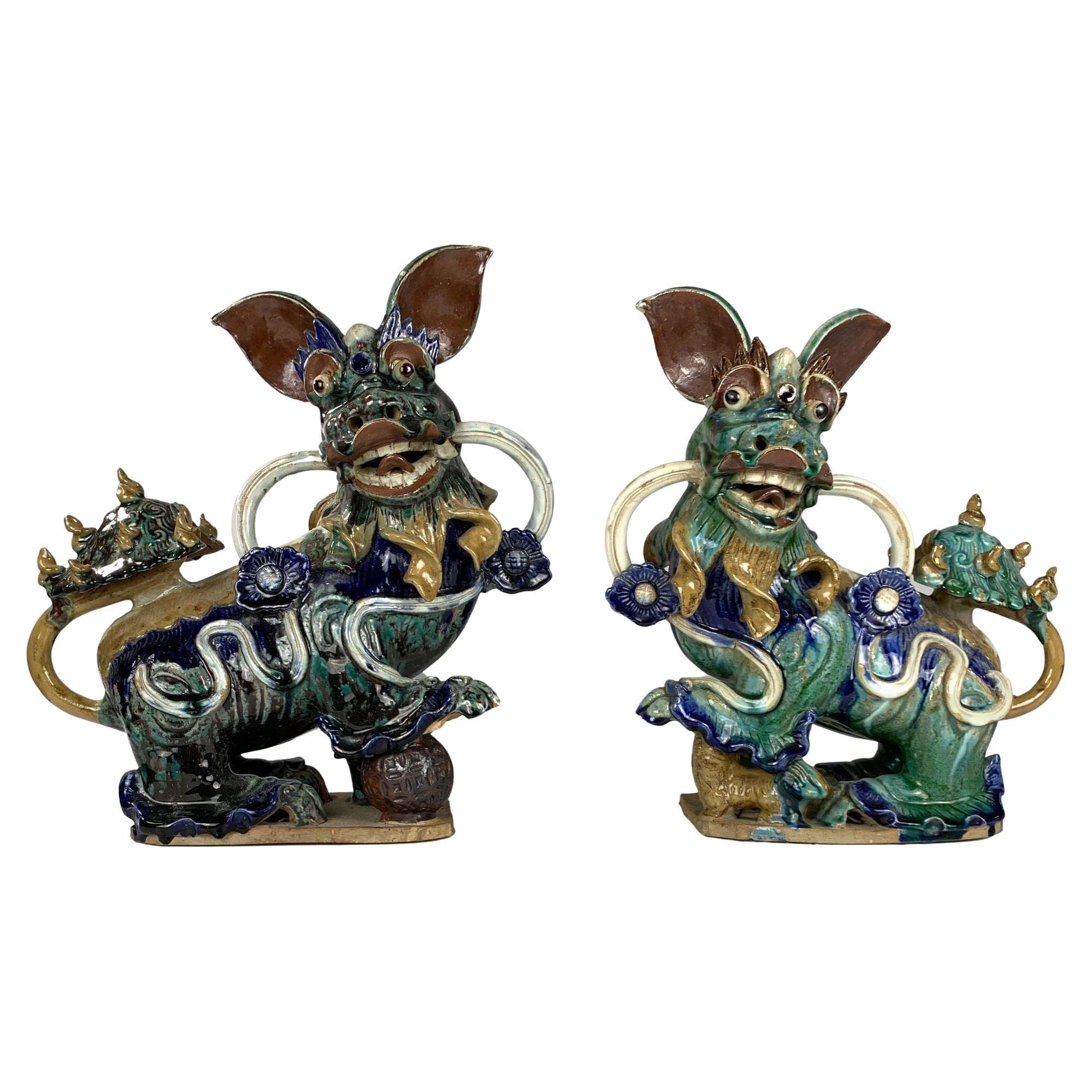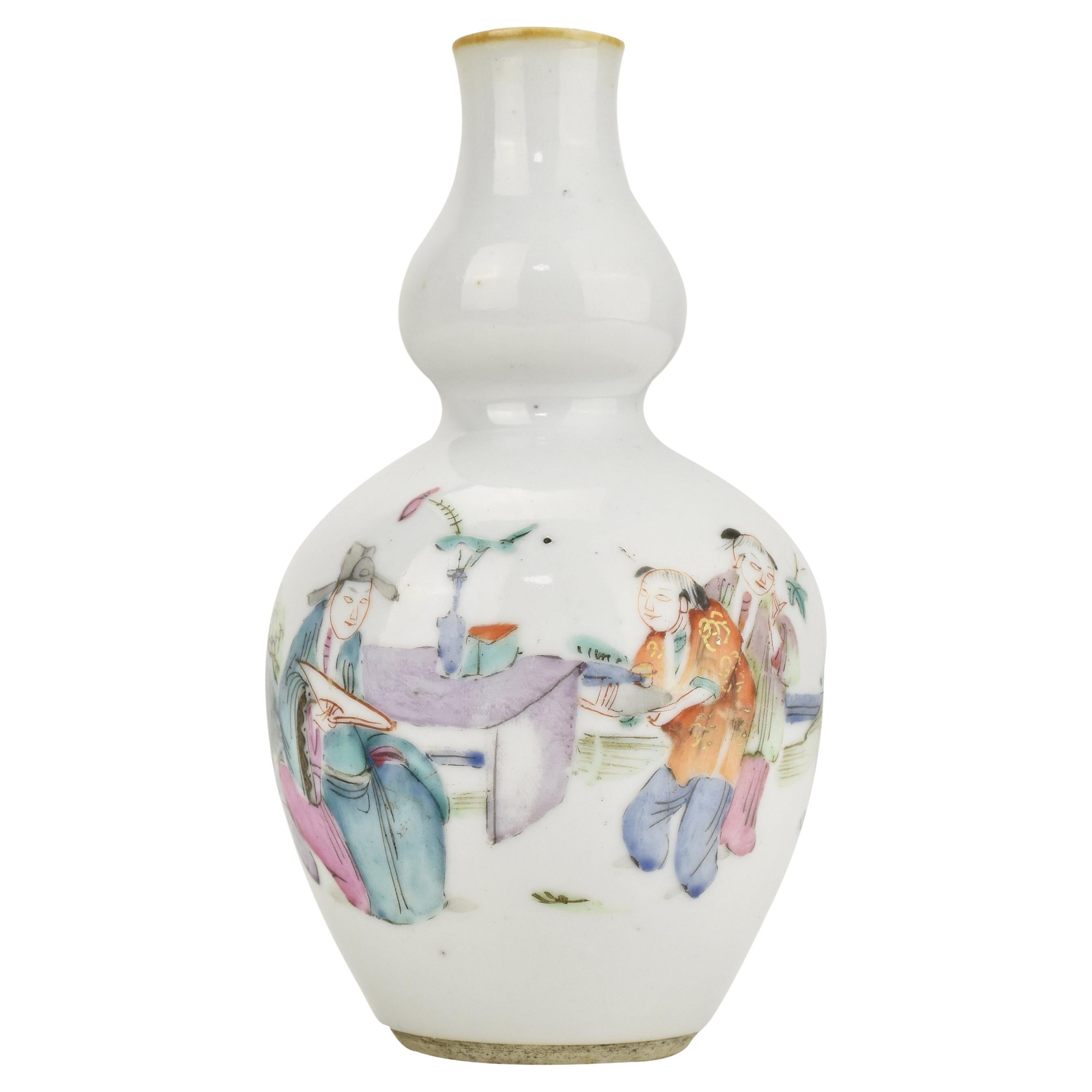Items Similar to Pair of 19th Century Qing Dynasty Faux Bamboo Chinese Vases
Video Loading
Want more images or videos?
Request additional images or videos from the seller
1 of 14
Pair of 19th Century Qing Dynasty Faux Bamboo Chinese Vases
About the Item
Faux bamboo Chinese vases were a type of decorative art that emerged during the Qing Dynasty (1644-1912) in China. These porcelain vases were designed to mimic the appearance of bamboo, a plant highly regarded in Chinese culture for its resilience, elegance, and symbolism. Bamboo is associated with attributes such as flexibility, strength, and modesty, making it a popular motif in Chinese art.
In the Qing Dynasty the color yellow held significant symbolism and represented imperial authority, power, and the emperor himself. Yellow was considered the most sacred and prestigious color in Chinese culture, and it had strong associations with the emperor's position as the Son of Heaven and the ruler of all under heaven.
The marks at the bottom of the vases indicate that these were crafted more specifically during the Tongzhi period – an emperor who reigned from 1861 to 1875, which effectively lasted nthrough his adolescence and was largly overshadowed by the rule of his mother, Empress Dowager Cixi. Although he had little influence over state affairs, the events of his reign gave rise to what historians call the “Tongzhi Restoration”, an unsuccessful modernization program.
The polychrome enamels representing on one vase a traditional Chinese kite and on the other a large lotus flower vase with three candles, further heighten the symbolism of the vases. As the emperor ascended to the throne as a child. Art and symbols were often employed to convey loyalty and respect to the imperial authority. The presence of lotus flowers and candles in the painting may serve as a way to wish the emperor purity, enlightenment, and good fortune. The Tongzhi period was marked by political turmoil and internal unrest, during such times, symbolic depictions in art, including kites, could carry subtle political messages or serve as a means of expressing dissent or hope for change.
- Dimensions:Height: 10.44 in (26.5 cm)Diameter: 4.34 in (11 cm)
- Sold As:Set of 2
- Style:Chinese Export (Of the Period)
- Materials and Techniques:
- Place of Origin:
- Period:
- Date of Manufacture:Late 19th Century
- Condition:Wear consistent with age and use.
- Seller Location:Ixelles, BE
- Reference Number:1stDibs: LU8924235546662
About the Seller
No Reviews Yet
Vetted Seller
These experienced sellers undergo a comprehensive evaluation by our team of in-house experts.
1stDibs seller since 2023
Typical response time: A week
- ShippingRetrieving quote...Ships From: Ixelles, Belgium
- Return PolicyA return for this item may be initiated within 14 days of delivery.
More From This SellerView All
- 19th Century Chinese Nankin Porcelain VaseLocated in Ixelles, BENanjing Porcelain, also known as Nanking Porcelain and referred to as "Nanjing" by Western dealers in the 19th century, was a type of Chinese porcela...Category
Antique 19th Century Chinese Chinese Export Ceramics
MaterialsPorcelain
- Pair of Late 19th Century Cantonese Famille Rose Vases in PorcelainLocated in Ixelles, BEFamille Rose refers to a type of Chinese porcelain characterized by the use of opaque, brightly colored enamels, prominently featuring shades of pink, purple, green, and yellow. The ...Category
Antique Late 19th Century Chinese Chinese Export Ceramics
MaterialsPorcelain
- Pair of Moon-Shaped Vases, China Late 19th CenturyLocated in Ixelles, BEA pair of large moon-shaped "flasks" vases painted in blue and white, each flask decorated with scenes of active characters and surrounded by borders of floral motifs and foliate pat...Category
Antique Late 19th Century Chinese Antiquities
MaterialsPorcelain
- Large Pair of Graduated Turquoise Porcelain Foo Dogs. Chinese Circa 1880Located in Ixelles, BEChinese turquoise-colored porcelain foo dogs from circa 1880 are exquisite examples of traditional Chinese ceramic art. Foo dogs, also known as guardian lions or temple lions, are ic...Category
Antique Late 19th Century Chinese Qing Ceramics
MaterialsCeramic
- Pair of Japanese Moriage Satsuma Vases with Gold Gilding Circa 1930-1940Located in Ixelles, BEJapanese Satsuma vases from the circa 1930-1940 period are a particular style of ceramic art that originated from the Satsuma province of Japan. Satsuma ware is renowned for its intricate hand-painted designs, rich colors, and distinctive crackled glaze. Satsuma ware dates back to the early 17th century, but it gained widespread popularity in the late 19th and early 20th centuries, including the 1930s and 1940s. Satsuma vases produced during this time often reflected a mix of traditional and modern influences, as Japan went through a period of cultural exchange and artistic experimentation. Satsuma vases are made from a type of Japanese earthenware clay known for its fine texture and malleability. The vases are hand-formed or wheel-thrown and then meticulously hand-painted with intricate designs using enamel paints. The distinctive crackled glaze was achieved by firing the vases at a relatively low temperature, allowing the glaze to crack during the cooling process. The moriage technique involves applying three-dimensional, raised ornamentation to the surface of the ceramic piece, creating a visually textured and layered effect. Artisans create three-dimensional patterns, designs, or intricate motifs using a special mixture of clay, slip, or porcelain paste. The raised elements are added by hand to the ceramic body, and each detail is carefully shaped to achieve the desired effect. The moriage is then gold gilded as some of the intricate ornamental patterns and the halos around the three immortal...Category
Early 20th Century Japanese Showa Ceramics
MaterialsPottery
- Marc Clauzade Painting of Saint Tropez Ref 086By Marc ClauzadeLocated in Ixelles, BEMarc Clauzade: Capturing the Essence of French Artistry Hailing from the vibrant city of Paris, Marc Clauzade stands as France’s most prominent living artistic asset, a testament to...Category
Late 20th Century French Paintings
MaterialsCanvas, Paint
You May Also Like
- Late 19th Century Qing Dynasty Matching Pair Chinese Famille Rose VasesLocated in Silvolde, GelderlandBeautiful set of two matching Qing Dynasty porcelain vases. These vase are both in good condition and add absolute great value to your interior.Category
Antique Late 19th Century Chinese Chinese Export Ceramics
MaterialsPorcelain
- Pair of Porcelain Jars "Rose Family" Cantón Qing Dynasty China 19th CenturyBy Europa AntiquesLocated in Madrid, ESPair of porcelain jars "Rose Family" from Cantón. Qing Dynasty. China, 19th century. Decoration of courtly scenes in cartouches and floral motifs. Lids to...Category
Antique 19th Century Chinese Chinese Export Ceramics
MaterialsPorcelain
- Pair Of Chinese Qing Dynasty VasesLocated in Essex, MADecorated with lotus branches and leaves , red enameled lotus base decorationCategory
Antique Late 19th Century Chinese Ceramics
MaterialsPorcelain
- Chinese Blue Flambe Glazed Hu Vase, Qing Dynasty, 19th Century, ChinaLocated in Austin, TXAn unusual and spectacular Chinese monochrome blue flambé-glazed hu form porcelain vase, Qing Dynasty, 19th century, China. The hu vase is heavily potted with elegant proportions...Category
Antique Early 19th Century Chinese Qing Ceramics
MaterialsPorcelain
- Pair Large Chinese Guardian Lions Qing Dynasty 19th CenturyLocated in Katonah, NYThese magnificent Chinese temple lions are true works of art, masterfully crafted with incredible attention to detail. The bulging eyes, sharp ears, open mouth, and fluttering mane are expertly rendered, creating a pair of stunning creatures that are truly alive with energy and movement. The expressive faces of these lions are captivating, and the fact that they are a "true" pair, meaning a male and a female facing each other, adds to the sense of interaction and action. These lions are made of stoneware and painted in the traditional Chinese sancai three-color glaze on a light brown ground; dating to the late Qing period, they are covered in rich green, blue, and amber glazes. The intricate detailing and rich colors are breathtaking, making these lions a treasure. Temple lions, also known as lion dogs, are celebrated for their auspicious symbolism and are believed to protect the peace and prosperity of one's home. These lions are beautiful works of art and bring good luck and prosperity to the home they are placed in. Dimensions: 17" Height x 16" Length x 6 1/2" Depth. Condition: Excellent Price: $6,800 Background of Chinese Temple Lions: Chinese guardian lions...Category
Antique Late 19th Century Qing Ceramics
MaterialsStoneware
- Antique Chinese Porcelain Famille Rose Vase Qing Dynasty 19th CenturyLocated in Bad Säckingen, DEAntique Chinese Famille Rose Vase with Hand-Painted Enamels Qing Dynasty This lovely small antique Chinese Famille Rose vase hails f...Category
Antique 1890s Chinese Ceramics
MaterialsEnamel
Recently Viewed
View AllMore Ways To Browse
Yellow Chinese Antique Vases
Popular Ceramics
Bamboo Flower Vase
Tongzhi Porcelain
China Antique Vase
Asian Emperors And Empress
Meiji Arita
Asian Brown And White Porcelain
Tong Dynasty
Kutani Temple Jar
Crystal Incense Burner
Old Satsuma
Antique Metal Brass Trim Bottle
Japanese White Stork
Blue Gold Imari
Chinese Lotus Plate
Sea Salvage
Song Ware
